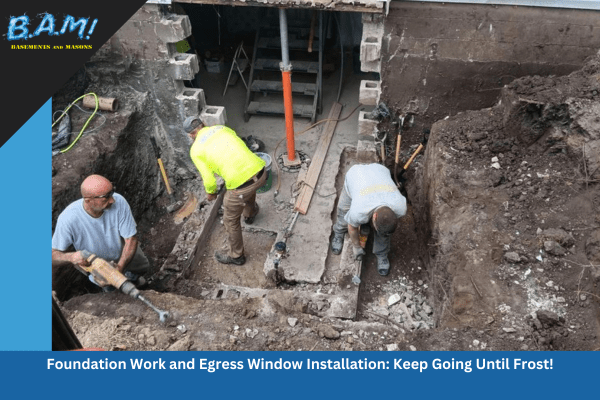Our Best Basement Waterproofing Statements
Our Best Basement Waterproofing Statements
Blog Article
Best Basement Waterproofing Fundamentals Explained
Table of ContentsWhat Does Best Basement Waterproofing Do?The Basic Principles Of Best Basement Waterproofing Best Basement Waterproofing Can Be Fun For AnyoneThe Ultimate Guide To Best Basement WaterproofingNot known Facts About Best Basement Waterproofing
uses excavation strategies towards all-time low of the structure's structure. includes getting rid of wetness after it has entered the cellar. AdvantaClean's skilled professionals and technicians will certainly find the water source. If wall surface or slab splits exist, we will inject polyurethane and epoxies right into the fractures and secure the compromise, stopping additional moisture from going into.Mounting cellar air flow systems, conditioning systems, or basement dehumidifier systems to get water out of your basement. Choosing AdvantaClean's basement waterproofing services is a reliable way to deal with dampness and protect against mold and mildew from jeopardizing the framework of your home and the health of your household.
If there's condensation on the exterior of the aluminum foil, you have high humidity in your basement. Repair it with a portable area dehumidifier or a whole-house humidifier system as opposed to waterproofing items. If the foil has condensation on the within surface (beside the wall), the dirt around your residence might be naturally damp from a high water table or poor soil drainage.
You can waterproof simply your indoor wall surfaces, which might address the issue. Or you can waterproof your outside walls, which is a better bet yet even more pricey. Below's the scoop on the various kinds: These thick coatings are cement-like. Once they dry, they stick permanently to concrete and masonry walls.
Our Best Basement Waterproofing Ideas
Swirl the brush at the last phase of application to offer the wall an attractive, finished look. Concrete water resistant coverings can't be applied to formerly painted surface areas; examine the tag. A 5-gallon pail prices concerning $60. Recognized as densifiers, they are suitable just for walls that have not been repainted or sealed.
However you clean, roll, or spray it on much even more thickly one gallon covers simply 75 square feet, not the 300 square feet regular with conventional paint. Water resistant paint is fine for do it yourself application. You can use it over painted surface areas, and paint over it once it's cured (one gallon prices $37).
It can cost $10,000 to $15,000, depending on the work required (Best Basement Waterproofing). Exterior waterproofing entails digging deep into all around the residence to the full depth of the foundation walls, after that mounting a water resistant coating or membrane covered by drainage panels.
Some Known Factual Statements About Best Basement Waterproofing
A basement without waterproofing is kind of like that. Your cellar doesn't want to go via a rainstorm without appropriate protection just as much as you don't want to.
Exterior waterproofing is a waterproofing technique that includes sealing your home from the exterior. The structure walls are then cleaned, sealed, and covered with a waterproof membrane layer or sealant.

The Basic Principles Of Best Basement Waterproofing
It's an extra engaged procedure that needs excavating up your backyard, which is expensive and taxing. Exterior waterproofing entails getting rid of whatever bordering the house, consisting of verandas, driveways, sidewalks, landscape design, a/c devices, decks, and more. If any one see this page of the job was done improperly and water is still entering your cellar, there isn't much you can do to remedy or fix it.
Interior cellar waterproofing involves waterproofing from the inside. Any water that leakages right into your basement is redirected prior to it touches your flooring. It's sort of like wearing a raincoat under your garments. It entails two points: a water drain track and a sump pump. It works by sealing the inside of your basement walls and floors so water that attempts to Get More Info go into is carried out with a sump pump.
It's an efficient approach to water-proof your basement. The drawback of interior cellar waterproofing primarily pertains to the setup procedure. This approach needs stored items, furniture, and built-in shelving or cabinets to be relocated from touching the cellar walls. And during setup, your basement can not be used. The biggest distinction between the 2 techniques is this: Exterior waterproofing is a preventative solution and interior waterproofing is a restorative service.
Rumored Buzz on Best Basement Waterproofing
To conclude, outside and interior basement waterproofing are both efficient techniques of shielding your home from water damage. Outside waterproofing creates a barrier that prevents water from entering your home, while indoor waterproofing reroutes water that does enter your home. And it is necessary to note that exterior waterproofing is an expensive and disruptive installment process when compared to indoor waterproofing.
Whichever approach you choose, make sure you pick a trusted and trustworthy service provider for the task. If you have any kind of inquiries about basement waterproofing, please reach out to us.
You can fill in our kind below. Best Basement Waterproofing, begin a conversation in the bottom right-hand edge, or call us at 1-800-827-0702
Report this page